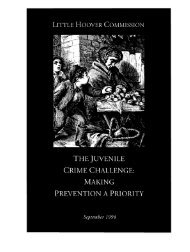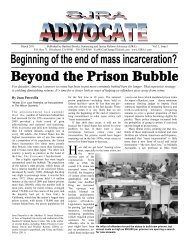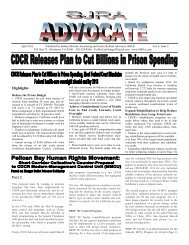Jailhouse Lawyer's Handbook - Sentencing and Justice Reform ...
Jailhouse Lawyer's Handbook - Sentencing and Justice Reform ...
Jailhouse Lawyer's Handbook - Sentencing and Justice Reform ...
Create successful ePaper yourself
Turn your PDF publications into a flip-book with our unique Google optimized e-Paper software.
Order of Precedents:<br />
Supreme Court. The most important<br />
precedents are decisions by the U.S. Supreme<br />
Court. Every court is supposed to follow these<br />
precedents.<br />
Appeals Court. The next best precedent is a<br />
decision of the appeals court for the circuit in<br />
which your district court is located. Every<br />
U.S. District Court in your circuit is supposed<br />
to follow the decisions of the Circuit Court,<br />
unless those decisions have been overruled by<br />
the Supreme Court.<br />
District Court. The third-best precedent is an<br />
earlier decision by the district court which is<br />
considering your suit. This may be by the<br />
judge who is in charge of your suit or by a<br />
different judge from the same court.<br />
The third-best precedent is an earlier decision by the<br />
district court which is considering your suit. This may<br />
be by the judge who is in charge of your suit or by a<br />
different judge from the same court.<br />
Some questions in your case may never have been<br />
decided by the Supreme Court, the Circuit Court, or<br />
your District Court. If this is the case, then you can<br />
point to decisions by U.S. Appeals Courts from other<br />
circuits or by other U.S. District Courts. Although a<br />
district court is not required to follow these kinds of<br />
precedents, it should consider them seriously. This is<br />
what is known as “persuasive authority.”<br />
Federal courts use the same method to enforce laws<br />
passed by the U.S. Congress, like Section 1983. These<br />
laws are called “statutes.” Judges interpret the words in<br />
these laws in court cases. This method also governs<br />
how judges apply the Federal Rules of Civil Procedure,<br />
which are made by the U.S. Supreme Court.<br />
punishment.” However, there is no way to know from<br />
those four words exactly which kinds of punishments<br />
are allowed <strong>and</strong> which aren’t. For instance, you may<br />
think to yourself that that execution is very “cruel <strong>and</strong><br />
unusual.” But, execution is legal in the United States.<br />
To underst<strong>and</strong> how judges interpret “cruel <strong>and</strong> unusual<br />
punishment” you need to read cases in which other<br />
people, in the past, argued that one type of punishment<br />
or another was “cruel <strong>and</strong> unusual” <strong>and</strong> see how they<br />
turned out.<br />
Each court decision is supposed to be based on an<br />
earlier decision, which is called “precedent.” To show<br />
that your constitutional rights have been violated, you<br />
point to good court decisions in earlier cases <strong>and</strong><br />
describe how the facts in those cases are similar to the<br />
facts in your case. You should also show how the<br />
general principles of constitutional law presented in the<br />
earlier decisions apply to your situation.<br />
Besides arguing from favorable precedents, you need to<br />
explain why bad court decisions which might appear to<br />
apply to your situation should not determine the<br />
decision in your case. Show how the facts in your case<br />
are different from the facts in the bad case. This is<br />
called “distinguishing” a case.<br />
The most important precedents are decisions by the<br />
U.S. Supreme Court. Every court is supposed to follow<br />
these precedents. The next best precedent is a decision<br />
of the appeals court for the circuit in which your district<br />
court is located. This is called “binding precedent”<br />
because it must be followed.<br />
Since statutes <strong>and</strong> rules are more specific than<br />
provisions in the Constitution, they leave less room for<br />
judicial interpretation. Still, the meaning of a key word<br />
or phrase is often unclear until a court has to apply it in<br />
specific situations.<br />
3. Other Grounds for Court Decisions<br />
Sometimes no precedent will be very close to your<br />
case, or you will find conflicting precedents from<br />
equally important courts. Other times there may be<br />
weak precedents which you will want to argue against.<br />
In these situations it helps to explain why a decision in<br />
your favor would be good precedent for future cases<br />
<strong>and</strong> would benefit society in general. This is called an<br />
argument based on “policy.”<br />
You can refer to books <strong>and</strong> articles by legal scholars to<br />
back up your arguments. Sometimes when a judge<br />
writes an opinion to explain his decision, he will set<br />
forth his views about a whole area of law which is<br />
relevant to that decision. Although the judge’s general<br />
views do not count as precedent (precedent is limited to<br />
the questions the court actually decides in a particular<br />
case), you can quote his view in support of your<br />
arguments just as you would quote a “legal treatise” or<br />
an article in a “law review.” A “legal treatise” is a book<br />
about one area of the law <strong>and</strong> a “law review” is a<br />
magazine or journal that has essays about different<br />
parts of the law written by legal scholars.<br />
JAILHOUSE LAWYERS HANDBOOK – CHAPTER SIX<br />
69





